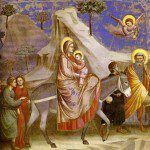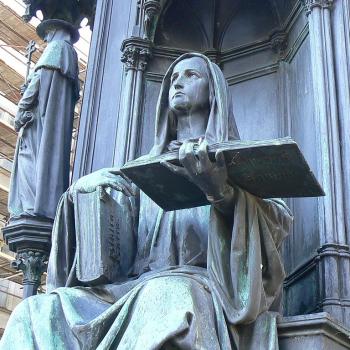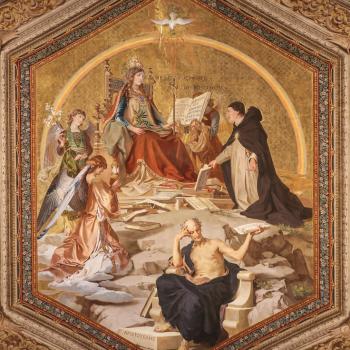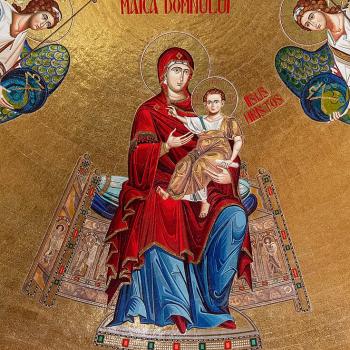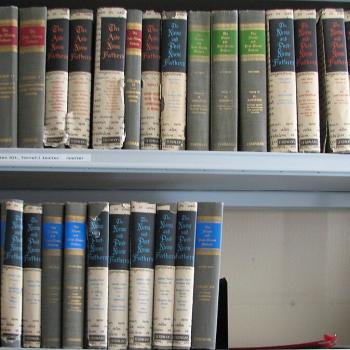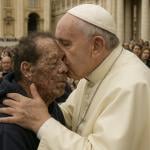![By Giotto (original fresco), SimonP (image from PD), Trelawnie (excerpt) (Public domain) [Public domain], via Wikimedia Commons](https://wp-media.patheos.com/blogs/sites/637/2016/04/Giotto_Flight_into_Egypt_excerpt-300x295.jpg)
While what has been said should be enough to indicate why Christians take the ever-virginity of the Mother of God seriously, there is another reason as to why the teaching is important and should be affirmed. It is because Jesus in his person presents to us the fullness of revelation, including with it, a revelation about the nature of the divinity itself. He reveals not just who he is independent of the Father and the Holy Spirit, but rather, he reveals, through himself, the whole Trinity to us. While each person of the Trinity has their own relational characteristics which distinguish them from each other, we must remember, since each person is fully God, wherever one is, all three are to be found, each in their own unique way, explaining how and why in and through Jesus we get a revelation not only of God the Son but of the whole Trinity.[1]
As is proper with the economic Trinity, the Trinity as it reveals itself to us, that what is represented by revelation must be in accord with the reality found within the immanent Trinity. How God the Son presents himself in and through his human nature must be fitting to who he is as a person.[2] The person of God the Word, God the Son, remains the same, even when he assumes human nature, so that who he is with his humanity must properly present to us who he is with his divinity, that is, his personal identity. This is why how he incarnated himself is important. Jesus, the Word of God, is the only-begotten son of the Father. In his humanity, to reflect this truth, he has become the only-begotten son of his mother, as St. Thomas Aquinas indicated:
For, in the first place, this is derogatory to Christ’s perfection: for as He is in His Godhead the Only-Begotten of the Father, being thus His Son in every respect perfect, so it was becoming that He should be the Only-begotten son of His Mother, as being her perfect offspring.[3]
What this means is that if Mary had other children, if Jesus had brothers and sisters born of Mary, such a fact would suggest that God the Father likewise beget more than the Logos, less his humanity does not perfectly represent who he is as a person. Yet this is denied by Jesus: he said that he was the only son of the Father (cf. John 3:16-8). Since a purpose of the incarnation was to reveal to us the Trinity and his place within the Trinity, being born of Mary, being born of a virgin who had no other children, he reveals he is, as a person, the “only-begotten one,” by making that true in relation to both of his natures, both of his births. He can have step-brothers and sisters, just as we can become adopted children of God the Father, but he must be the unique son of his mother to show to the world he is the unique son of the Father.
Now some would say that the theological principles which have been brought up and discussed are good in theory, but seem to contradict Scripture, and so should be rejected. They think Joseph and Mary had children together. Thus, they ask, why does Scripture say, “but [Joseph] knew her not until she had borne a son; and he called his name Jesus” (Matt 1:25)? Does this not indicate that after Jesus was born, Joseph consummated his marriage with Mary? And do we not see references to brothers and sisters for Christ, giving strength to this position? We will look at who these brothers and sister could be in a later discussion; right now it is important to demonstrate Matthew 1:25 does not indicate that Joseph had to consummate his marriage. The intent of the verse was indicate that from the time of his engagement with Mary, and throughout the time Mary was pregnant, they had no sexual contact, so as to promote the virgin birth of Jesus.
The first thing to recognize is that the word until, in any language, is a vague term. It does not indicate any necessary consequence once we reach the point of time that our use of the word until referred. To see this, we just need to examine what we would mean if we were to tell someone, “I am not going to talk to you again until the day I die.” By saying that, we would not mean that we plan to talk to them the day we die; rather, we plan never to talk to them again. We see this in Scripture, when we read: “And Michal the daughter of Saul had no child to the day of her death” (2Sam 6:23). Do we say the day Michal died, she had a child? Certainly not. We must keep this in mind, therefore, when we read Matthew 1:25. That verse says nothing about what happened after Jesus was born; it was only concerned about indicating that before he was born, there was no conjugal union. And so, we can follow St. John Chrysostom in his explanation of the verse:
And when he had taken her, “he knew her not, till she had brought forth her first-born Son.” He has here used the word “till,” not that you should suspect that afterwards he did know her, but to inform you that before the birth the Virgin was wholly untouched by man. But why then, it may be said, has he used the word, “till”? Because it is usual in Scripture often to do this, and to use this expression without reference to limited times. For so with respect to the ark likewise, it is said, “The raven returned not till the earth was dried up.” And yet it did not return even after that time. And when discoursing also of God, the Scripture says, “From age until age You are,” not as fixing limits in this case. And again when it is preaching the Gospel beforehand, and saying, “In his days shall righteousness flourish, and abundance of peace, till the moon be taken away,” it does not set a limit to this fair part of creation. So then here likewise, it uses the word “till,” to make certain what was before the birth, but as to what follows, it leaves you to make the inference. Thus, what it was necessary for you to learn of Him, this He Himself has said; that the Virgin was untouched by man until the birth; but that which both was seen to be a consequence of the former statement, and was acknowledged, this in its turn he leaves for you to perceive; namely, that not even after this, she having so become a mother, and having been counted worthy of a new sort of travail, and a child-bearing so strange, could that righteous man ever have endured to know her.[4]
And this is why the text must not be read as saying that Joseph and Mary consummated their union after the birth of Jesus. It is a misreading of the text and its intent, which is to demonstrate the virgin birth of Jesus and nothing other than that.
More to Come
[1] This is why Jesus said he is in the Father and the Father is in him (cf. John 14:11). The divinity is united as one even though the persons remain relatively distinct from each other. Where one is, the essence is, and where the essence is, all three persons are to be found. St. John of Damascus explained this by pointing out how the three persons “adhere to each other” working together as one: “The abiding and resting of the Persons in one another is not in such a manner that they coalesce or become confused, but rather, so that they adhere to one another, for they are without interval between them and inseparable and their mutual indwelling is without confusion. For the Son is in the Father and the Spirit, and the Spirit is in the Father and the Son, and the Father is in the Son and the Spirit, and there is no merging or blending our confusion. And there is one surge and one movement of the three Persons,” St. John of Damascus, “An Exact Expositions on the Orthodox Faith” in Saint John of Damascus: Writings. trans. Fredric H. Chase, Jr. ( New York: The Catholic University of America Press, 1958), 202.
[2] For further discussion on the relationship between the economic and immanent Trinity, see Karl Rahner, The Trinity. trans. Joseph Donceel (New York: Crossword Publishing Company, 1998), 21-24.
[3] St. Thomas Aquinas, Summa Theologica. trans. Fathers of the English Dominican Province (New York: Benziger Bros. edition, 1947), III-xxviii.3.
[4] St. John Chrysostom, Homilies on Matthew in NPNF1(10):33.
Stay in touch! Like A Little Bit of Nothing on Facebook:
A Little Bit of Nothing


